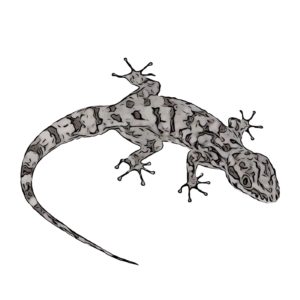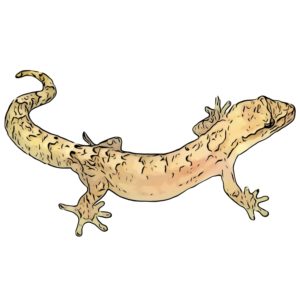General Description
Of the 12 Leaf-toed Geckos that occur in the Galapagos, 11 are endemic and 1 (Coastal Leaf-toed Gecko) has been introduced. All these geckos have a similar body coloration – an overall whitish body with variable dark brown blotches and markings on their upperparts. They can be distinguished from all other gecko species on the Galapagos, namely Mourning, Common House and Shieldhead, by their thin, terminally padded didgits. Most Leaf-toed Geckos on the Galapagos measure between 8 and 10cm with the exception of the much larger Darwin’s and Coastal Leaf-toed Gecko which measure up to twice as much. Sexes are similar in all species, varying only slighly in size (in most cases not enough to distinguish in them field).
Andy Sabin's Leaf-toed Gecko
Phyllodactylus andysabini
Endangered. Locally common endemic resident. Endemic to northern Isabela around Wolf Volcano. The only gecko to occur around Wolf Volcano. This species is listed as endangered due to its restricted range, and a possible population decline due to predation by cats and rats. It is also threatened by the possible eruption of Wolf Volcano.
Santa Fe Leaf-toed Gecko
Phyllodactylus barringtonensis
Near Threatened. Very common localized endemic. Endemic to Santa Fe and its adjacent islets. The only gecko on Santa Fe. Listed as near threatened due to its small range leaving it vulnerable to stochastic events.
Floreana Leaf-toed Gecko
Phyllodactylus baurii
Near Threatened. Very common endemic resident. Found on Floreana and adjacent Champion, Enderby and Gardner Islets. Co-occurs with Mourning Gecko in urban areas on Floreana. It is best seperated from Mourning Gecko by its rounded ‘toes’. Near threatened due to predation by domestic cats. May also face competition from introduced Mourning Gecko.
Darwin's Leaf-toed Gecko
Phyllodactylus darwini
Near Threatened. Common endemic resident. Endemic to San Cristobal. This species is one of six gecko species on San Cristobal. It can be separated from all 5 other species by the bumps on both its tail and its back. Near Threattened due to predation by house cats and possible competition with introduced gecko species.
Pinzon Leaf-toed Gecko
Phyllodactylus duncanensis
Vulnerable. Fairly common, localized endemic resident. Endemic to Pinzon. The only gecko on Pinzon. This specie’s limited range leaves it vulnerable to stochastic events.
Galapagos Leaf-toed Gecko
Phyllodactylus galapagensis
Near Threatened. Common endemic resident. Found on Baltra, North Seymour and the lowlands of Santa Cruz as well as adjacent islets. Within its range, it is most similar to the much larger Coastal Leaf-toed Gecko. Appart from size, Galapagos Leaf-toed Geckos differ from Coastal Leaf-toed Geckos by having a more contrasting dark brown and whitish body patterning. Rated as Near Threatened due to predation by domestic cats and competition by introduced gecko species.
Wolf Leaf-toed Gecko
Phyllodactylus gilberti
Vulnerable. Very common localized endemic. Found on Wolf and Darwin Islands. The only gecko on Wolf and Darwin islands. Small range leaves it vulnerable to stochastic events.
Espanola Leaf-toed Gecko
Phyllodactylus gorii
Near Threatened. Common localized endemic. Found only on Espanola and adjacent Gardner and Osborn Islets. The only gecko on and around Espanola. Small range leaves it vulnerable to stochastic events.
San Cristobal Leaf-toed Gecko
Phyllodactylus leei
Near Threatened. Common endemic resident. Endemic to San Cristobal. Occurs with 5 other gecko species on San Cristobal. Within this range, it is most similar to the significantly Coastal and Darwin’s Leaf-toed Geckos. This is the only gecko on San Cristobal with no bumps on its back or tail. Although there is no evidence that the population of this species is declining, it is threatened by predation by domestic cats and may be facing competition from introduced gecko species (these are restricted to urban areas however).
Mares Leaf-toed Gecko
Phyllodactylus maresi
Least Concern. Fairly common endemic resident. The only gecko within its range. Found on the lowlands of Santiago, Mares Islet, Rabida, Bartolome and Marchena.
Coastal Leaf-toed Gecko
Phyllodactylus reissii
Least Concern. Very common, introduced species found exclusively in urban environments. An introduced species from the lowlands of west ecuador and north west peru that has become established in towns such as Puerto Ayora, Puerto Baquerizo Moreno, Puerto Villamil, Puerto Velasco Ibarra and Baltra airport. Seperated from all co-occuring Galapagos geckos by large size, evenly spaced bumps on it back and its smooth tail.
Simpson's Leaf-toed Gecko
Phyllodactylus simpsoni
Near Threatened. Common endemic resident. Found on Fernandina and central and south Isabela as well as adjacent Cowley and Tortuga Islets. The only gecko throughout most of its range, overlapping with the four introduced species of geckos only in urban areas. Of these, it is distinguished from the most similar Coastal Leaf-toed Gecko by its significantly smaller size. Predation by housecats and displacement by introduced gecko species on Isabella. No introduced species on Fernandina.


